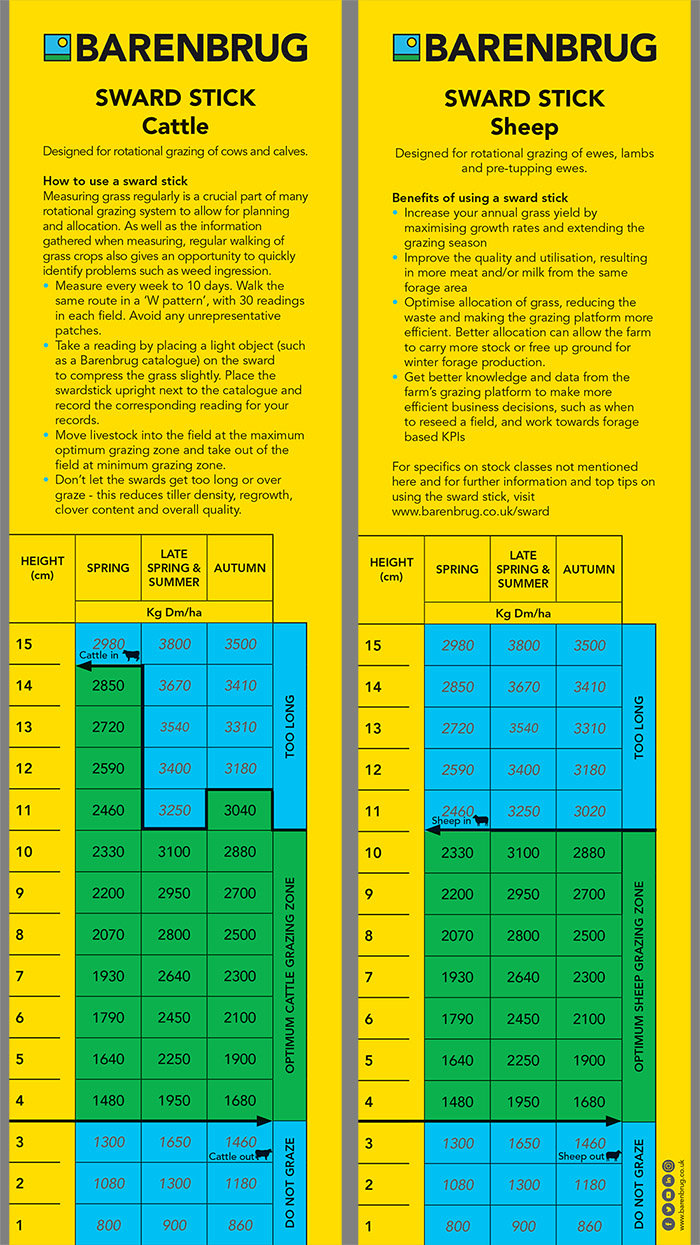- Try to measure every week or at the most every 10 days. Leaving it any longer can mean missing very important information about the fields and optimal grazing windows.
- Walk the same route in the field every time, taking around 30 readings in each field. Ideally, take the same number of samples each time. We suggest using a ‘W pattern’ across the field, the same as you would for a soil sample, and avoid any unrepresentative patches such as gateways, around water troughs or patches of weeds. For consistency, it is better if the same person walks the fields each time.
- To take a reading, place an object, such as a Barenbrug catalogue, on the sward to compress the grass slightly and then place the swardstick upright next to the catalogue and note the corresponding kg DM/ha reading.
- Record each reading and calculate and average for each field. Recording in a notebook is useful when out in the field but keeping digital records will be more useful to calculate the averages and to build up a record of each fields performance over time.
It is a good idea to keep historical records as well as current ones to let you see how your fields are performing over time and if you are making the improvements that you have set out to achieve. Having a large bank of information which is specific to your farm, not just a local region for example, is useful for any livestock enterprise for benchmarking, making nutrient plans and setting out grazing plans for cattle and/or sheep.
Another good reason to keep historical data is to allow tweaking of management plans within a season. For example you could calculate an average cover one week this year and find that average covers are 500kg DM/ha lower this year than the same week last year. This might be able to be explained by colder weather slowing growth rates however if conditions have been the same or better, this highlights that some further investigation into soil structure or fertility or grazing practises may be required.
When to move livestock in and out of a field
Rotation lengths will vary dependant on the time of year, class of stock, the weather, climate and topography etc. but the key is to be entering and exiting livestock into a field at target heights to maximise yields, quality and utilisation. Use the suggested optimum grazing zone, for your specific livestock, as the indication of when to put your livestock in to the field (between 11-15cm) and always ensure the livestock come out of the field at the minimum, acround 3cm.
Entering a paddock when the grass has become too long may result in higher total dry matter but as grass matures, the grazing quality becomes sub-optimal. This can lead to lower utilisation - and therefore production – and can result in a rough, poorly grazed paddock on exit. If you have any paddocks with excessively high covers for the stock class on the grazing platform, consider taking these out the grazing rotation and cutting for silage.
Entering a paddock too early, before a second new tiller leaf last appears, can damage persistency of the sward and the yield potential.
Exiting a paddock too late, or over grazing, will leave too low a residual and results in slow regrowth because the plant is reliant on its carbohydrate reserves and not immediately able to photosynthesise due to the lack of green leaf area. A paddock like this can have a knock on effect into the future grazing rotation, particularly where growth rates are slow.
ORDER YOUR FREE SWARDSTICK HERE!




